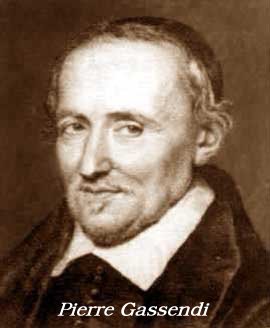Pierre Gassendi
Today, what happened after Galileo? The University of Houston's College of Engineering presents this series about the machines that make our civilization run, and the people whose ingenuity created them.
Galileo was a hard act to follow. He died the year Isaac Newton was born, but Newton's day wouldn't dawn 'til half a century later. Much of the dust kicked up by Galileo in the early seventeenth century would settle by then. So let's look at Galileo's immediate wake.

The person to meet is French philosopher Pierre Gassendi -- born in 1592, 28 years after Galileo and four years before his fellow philosopher Descartes. Gassendi became a priest and, at 25, began a five-year stint teaching about Aristotle.
By this time, the noose of the Inquisition had not yet tightened around Galileo's neck; but it soon would. Galileo's earlier writings, critical of Aristotle's science were well known, and Gassendi had read them. He was already skeptical of Aristotle, and now he picked up his own attack.
Well, not just on Aristotle, but on the whole philosophy of scholasticism. When you read about Gassendi, you usually get learned philosophical treatises that miss much of the technical content of his work. Here's an example:
Gassendi believed in empiricism. Galileo, had reasoned that, if you drop an object within some moving framework, it will share in the motion of that frame. While Gassendi accepted that, he knew it needed experimental verification. So he arranged to have a weight dropped from the mast of a rapidly moving ship. The weight landed at the foot of the mast and not behind it.
In 1640, that experiment gave enormous validity to Copernican dynamics, and it might've saved Galileo from some of his troubles. It's also the key to demonstrating why a satellite orbits, rather than falling straight down to Earth.
Gassendi's greatest contribution was breathing life back into the atomic theory. The scholastics had taken the old Greek idea that all matter is formed of four essences, Earth, Air, Fire, and Water. Galileo had opposed that. Gassendi went further. He correctly said that all material phenomena arise from the indestructible motion of atoms -- that the makeup of anything is based on incessant atomic motion. He used that fact to explain air pressure.
He attacked another scholastic view when he argued that time and space exist, whether or not anything is happening within them. That's the basis of Newtonian mechanics, although it's taken some-thing of a beating from relativity theory.
As an engineer, I like to look at anything as rarified as Gassendi's philosophy and say, "Yes, but where does the cement come out?" In Gassendi's case, the cement came out of the mixer in the form of the robust experimental science established during the mid-1600s.
That's why Gassendi was able to give us a number for the speed of sound on a normal day at Earth's surface. It was within seven percent of the correct value. He also influenced the writer Cyrano de Bergerac to begin writing science fiction. And all that, four hundred years ago!
I'm John Lienhard, at the University of Houston, where we're interested in the way inventive minds work.
B. Rochot, Gassendi (Gassend), Pierre. Dictionary of Scientific Biography (C.C. Gilespie, ed.) New York: Charles Scribner's Sons, 1970-1980.